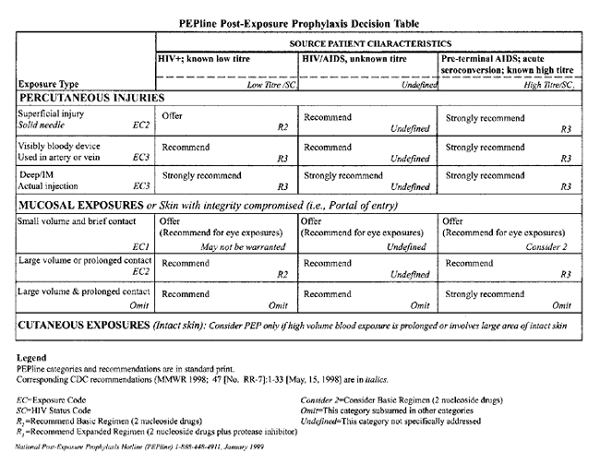Workers may want PEP, but often it’s unnecessary
Workers may want PEP, but often it’s unnecessary
The fear . . . can be enormous’
A significant number of health care workers may be taking unnecessary prophylactic medications after needlesticks, a post-exposure hotline has found.
Fearful health care workers may be taking a toxic three-drug regimen after a needlestick when a less toxic combination of two drugs, or none at all, may be the recommended response, say physicians at PEPline, a national post-exposure hotline at San Francisco General Hospital.
A review of PEPline data showed that in 4,253 consultations in the hotline’s first year, 58% re-sulted in a recommendation to stop or not start post-exposure prophylaxis. Seven percent of callers reported having initiated or receiving two- or three-drug regimens after an event that was not a true exposure.1
The risk of transmission of HIV after bloodborne exposure with a known source patient is .3%.2 Side effects of the anti-viral drugs include nausea, fatigue, vomiting, and diarrhea, as well as possible toxic effects to the liver and kidneys. While the drugs can be effective in preventing seroconversion, they need to be targeted to the right individuals, says David Bangsberg, MD, MPH, director of the Epidemiology and Preven-tion Interventions Center at San Francisco General Hospital and co-director of PEPline.
"The vast majority of people will remain uninfected whether they get post-exposure prophylaxis or not," says Bangsberg. "There’s a real priority to minimize toxicity in those people who would remain uninfected with or without PEP. In the general community, we think overtreatment for post-exposure prophylaxis is probably more common than undertreatment."
PEPline began in 1997 as a way to provide expertise to health care workers and clinicians around the country. It now receives more than 7,000 calls a year. PEPline provides advice about any bloodborne pathogen, including hepatitis B and C. But HIV prompts the greatest focus because of questions about the prophylactic treatment.
In the traumatic moments after an exposure, PEPline can provide vital counseling as well as assessment of risk. "The fear of contracting an infectious disease such as hepatitis or AIDS can be enormous," says Ronald H. Goldschmidt, MD, director of the family practice inpatient service at San Francisco General Hospital and co-director of PEPline. "Health care workers need to receive proper counseling and advice."
Goldschmidt says the risk assessment needs to be swift and thorough. If prophylaxis is indicated, it needs to be available immediately, he explains. (See risk assessment chart, p. 12.)
 |
"What we know from case-controlled studies in the past is that prophylaxis appears to decrease the transmission of HIV substantially — as much as 80%," Goldschmidt says. "It should be given promptly. What would be recommended would be within four hours if at all possible, but we would prescribe it up to 48 or 72 hours [after exposure] if the risk is substantial."
Emotional reactions or misinformation can lead to an incorrect assessment of risk. For example, if the blood of a known HIV-positive patient splashed on the intact skin of a health care worker who immediately washed it off, "we would want to discourage them from taking any prophylactic medicines because there’s probably no risk," says Goldschmidt.
On the other hand, a health care worker may erroneously believe that only hollow-bore needles present an exposure risk and that a needlestick from a suture needle isn’t a potential problem. "There certainly could be a risk if the source patient were HIV positive," he says.
Even if the risk is clear, the exact regimen may not be. PEPline clinicians answer questions about the best antiviral drugs to use, and how the choice may be influenced by the viral load or drug regimen of the source patient.
"The problem is to get the expertise we need at the right place at the right time. The PEPline can serve that function," says David K. Henderson, MD, deputy director for clinical care at the Warren G. Magnuson Clinical Center of the National Institutes of Health in Bethesda, MD. "It is a national resource."
PEPline may be of most use to hospitals that don’t have in-house expertise on HIV exposure. But even experts can benefit from collaboration, says Henderson.
"In complicated cases, I wouldn’t hesitate to call them just to get another view," he says. "Often there isn’t a right answer to these very complicated questions. What you want to know is how a smart person will manage this . . . and that’s the kind of information you can get from the PEPline."
[Editor’s note: To contact PEPline, which is available 24 hours a day, call (888) 448-4911. Information on PEPline is also available on the Internet at http://pepline.ucsf.edu.]
References
1. Bangsberg D and Goldschmidt RH. Postexposure Prophylaxis for Occupational Exposure to HIV (letter). JAMA 1999;(282):1,623-1,624.
2. Bell DM, Shapiro CN, Ciesielski CA, et al. Preventing bloodborne pathogen transmission from health-care workers to patients: The CDC perspective. Surgical Clinics of North America 1995;75:1,189-1,203.
